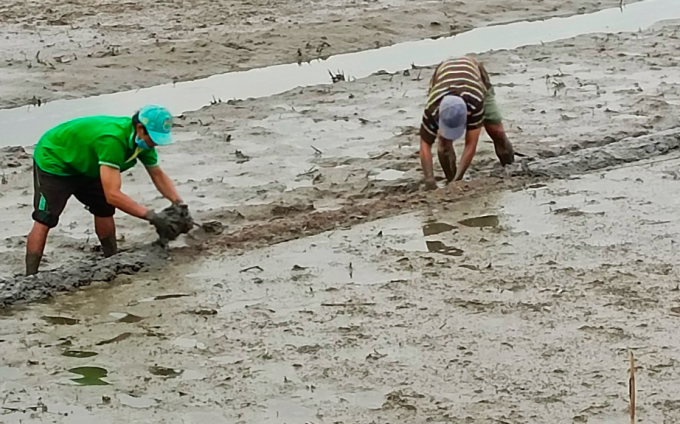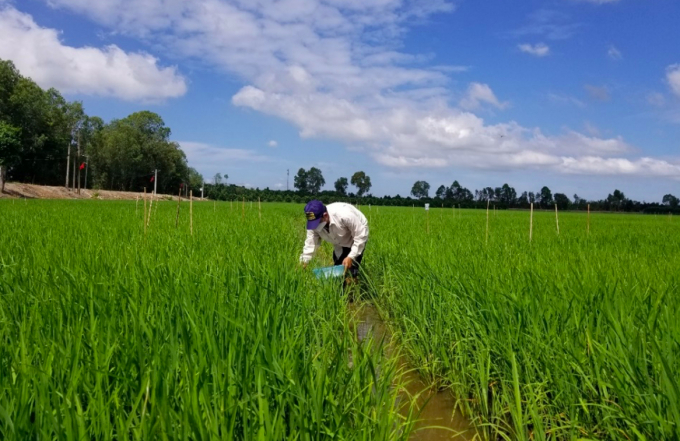June 19, 2025 | 08:16 GMT +7
June 19, 2025 | 08:16 GMT +7
Hotline: 0913.378.918
June 19, 2025 | 08:16 GMT +7
Hotline: 0913.378.918
This is the result of an experiment that the Department of Cultivation and Plant Protection of Tien Giang province carried out on the winter-spring crop 2021 - 2022 in Cai Be district.
Currently, in intensive rice farming, farmers still use a lot of fertilizers. However, the increasing price of fertilizer, especially during the Covid-19 pandemic, has greatly affected farmers' profits.

Partition to experiment with fertilizers reduction on rice transplants in Mr. Nguyen Van Thang's field in My Tan commune, Cai Be district, Tien Giang province. Photo: Minh Dam.
Moreover, the problem of losses during fertilizer use is on the rise. The reason is that farmers fertilize in excess of the recommended dosage and do not apply fertilizers following the "4 right" principle, so fertilizers are moved, washed away and evaporated, causing great waste and also polluting the environment.
Recently, the Department of Cultivation and Plant Protection of Tien Giang province has carried out an experiment and model to evaluate the efficiency of fertilizer use on rice in the field of Mr. Nguyen Van Thang in My Tan commune, Cai Be district with OM18 rice variety, sowing quantity is 100 kg/ha. The experiment aimed to find the most optimal formula and determine the technical and economic efficiency of saving fertilizers, mainly nitrogen fertilizers (N).
The experiment was arranged in a completely randomized block design, including 5 treatments, 5
Rice is one of the main crops in Tien Giang province. The province's annual rice cultivation area is over 136,000 hectares, with an output of over 800,000 tons. Rice is grown intensively with 3 crops/year for the western districts and 2 crops/year for the eastern districts of the province.
fertilizer formulas. In which, the control treatment applied fertilizer according to the formula of 90 N - 40 P2O5 - 30 K2O. This formula is equivalent to 150kg Urea, 100kg DAP and 50kg K2O per hectare. Treatments to reduce N amount: 10%, 20%, 30% and 30%, respectively, combined with microbial organic fertilizers. The treatments were repeated 3 times.
According to the experimental results, farmers can reduce the amount of fertilizer by up to 30% without reducing yield. In particular, when reducing the amount of N by 30% in combination with microbial organic fertilizers, the yield was nearly 1 ton/ha higher. From an economic point of view, it is possible to reduce nitrogen fertilizers by up to 20% without sacrificing profits.
The study showed that the treatment with 10% reduction in N amount gave an actual yield of nearly 6.3 tons/ha, 0.6 tons/ha higher than the control and the profit was over 25 million VND/ha, 5 million VND/ha higher than the control. This is the treatment with optimal results, which is significant in rice production because the reduction of nitrogen fertilizer contributes to the reduction of pests and diseases. Especially, in the face of high fertilizer prices, saving production costs through reducing product costs has brought better profits to farmers.

Fertilize following the treatments in experimental fields. Photo: Minh Dam.
The research results also show that, although the 30% reduction of N combined with microbial organic fertilizers has a lower efficiency of 0.72 million VND/ha, in the long run, it has an important meaning in limiting the use of chemical fertilizers to increase soil fertility.
Since then, Mr. Vo Van Men, Director of the Department of Cultivation and Plant Protection of Tien Giang province recommended: To contribute to reducing costs and increasing profits in winter-spring rice production in Cai Be district, it is possible to use fertilizer following the formula 81 N - 40 P2O5 - 30 K2O.
The Department of Cultivation and Plant Protection of Tien Giang province also suggested that the Provincial Agricultural Extension and Service Center along with the Agricultural Service Center of the western districts and towns of Tien Giang continue to conduct experiments to evaluate the efficiency of fertilizer savings in the spring-summer and summer-autumn crops of 2022. Implement demonstration models to reduce fertilizer in the winter-spring rice crop of 2022 - 2023 with treatments to reduce nitrogen fertilizer at the rate of 10% and 30% in combination with microbial organic fertilizers.
Simultaneously, perform demonstration models of economical fertilizer reduction in the spring-summer and summer-autumn rice crops of 2023 on the basis of technically and economically effective treatments to recommend replication and application in rice production in the following years.
Mr. Do Van Van, Director of the Southern Plant Protection Center (Department of Plant Protection) said: In the western districts of Tien Giang province, the fertility and texture of the soil are mostly similar, so rice farmers are recommended to use a 10% nitrogen reduction formula.
In fact, many farmers still fertilize habitually with a higher dose than the standard formula. Therefore, people can reduce their dosage by over 10%, as long as they ensure the minimum formula (81 N - 40 P2O5 - 30 K2O), approximately 13kg Urea, 10kg DAP and 5kg K2O for 1 labour (1,000m2). Farmers should pay attention to reducing the amount of seed sown to 10 kg/labour.
Translated by Nguyen Hai Long
![Turning wind and rain into action: [9] Digitizing hydrometeorological data in response to climate change](https://t.ex-cdn.com/nongnghiepmoitruong.vn/608w/files/news/2025/06/17/z6704423696987_15fd32ffc26d590d204d520c9dac6786-nongnghiep-165943.jpg)
(VAN) Farmers have begun accessing hydrometeorological applications to adjust their cropping schedules, aiming to ensure productivity and adapt to climate change.
![Turning wind and rain into action: [8] Real-time salinity detection and early warning technology](https://t.ex-cdn.com/nongnghiepmoitruong.vn/608w/files/news/2025/06/17/z6704423696987_15fd32ffc26d590d204d520c9dac6786-nongnghiep-151127.jpg)
(VAN) Thanks to the integration of modern hydrological-hydraulic models, remote sensing technologies, and artificial intelligence, the accuracy of hydrological forecasting has significantly improved.
![Turning wind and rain into action: [7] Early disaster warnings help marine farmers minimize losses](https://t.ex-cdn.com/nongnghiepmoitruong.vn/608w/files/news/2025/06/17/z6704423696987_15fd32ffc26d590d204d520c9dac6786-nongnghiep-142942.jpg)
(VAN) In recent years, thanks to early disaster warnings and forecasting, marine farmers in Khanh Hoa province have been able to reduce risks and losses, thereby improving production efficiency.
![Turning wind and rain into action: [6] ‘Four on-the-spot’ disaster management software](https://t.ex-cdn.com/nongnghiepmoitruong.vn/608w/files/news/2025/06/17/e5a48259d6a262fc3bb3-nongnghiep-183800.jpg)
(VAN) By simply activating the scenario on the disaster management software, the relevant authorities immediately know how many households need to be evacuated, where to evacuate them to, and by what means of transportation…
![Turning wind and rain into action: [5] Hue applies modern technology in disaster forecasting](https://t.ex-cdn.com/nongnghiepmoitruong.vn/608w/files/news/2025/06/17/z6704423696987_15fd32ffc26d590d204d520c9dac6786-nongnghiep-093938.jpg)
(VAN) In Hue city, modern technology has recently been applied in meteorological and hydrological forecasting and warning, helping to reduce the damage caused by natural disasters.

(VAN) A cutting-edge farming technique being implemented on an experimental ranch in Arizona's Sonoran Desert has already saved a billion gallons of water over five years, according to Civil Eats.

(VAN) Poultry and pig production and the environment can be boosted through enhanced water technology, according to new research.